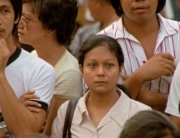Written & Directed by Angelina Maccarone
Produced by Gerd Haag, Serge Lalou, Michael Trabitzsch & Charlotte Uzu
Released by Kino Lorber
French with English subtitles
Germany/France. 94 min. Not rated
With Charlotte Rampling, Paul Auster, Peter Lindbergh & Jurgen Teller
In her intriguing documentary about the eponymous British actress, director Angelina Maccarone employs an ingenious structure that prevents the movie from turning into merely a career chronology. She divides the film into nine sections (title cards announce them, from “Exposure” to “Love”), each with Charlotte Rampling interacting with artist friends, like author Paul Auster and photographer Peter Lindbergh, or her son, director Barnaby Southcombe. Maccarone then intercuts excerpts from one of Rampling’s dozens of films to further illustrate the theme.
Rampling, who became one of the most recognizable international stars of the past decade in films by French directors François Ozon (Swimming Pool, Under the Sand) and Laurent Cantet (Heading South), had a healthy career for over 30 years before her current renaissance, as Maccarone’s portrait points out. The first part, “Exposure,” which shows her and Lindbergh taking turns posing for each other‘s camera, includes clips from Woody Allen’s Stardust Memories (1980), in which Rampling memorably played a narcissistic beauty.
Maccarone pairs the indelible close-ups of Rampling repeating her emotionally needy lines from Allen’s film with the actress and Lindbergh, some 30 years later, happily taking photos of each other. The director’s conceit—to present specific topics like “Age,” “Beauty” or “Death” and link them to scenes from Rampling’s films and her own relationships—works well enough for 90 minutes. But what the movie best achieves is to remind us how long this veteran actress has been working. Throughout, Rampling comes across as a fiercely intelligent woman secure in her own skin and a compelling actress secure in her own career choices.
I didn’t even remember that Rampling co-starred in the 1966 classic Georgy Girl with Lynn Redgrave and Alan Bates or 1982’s The Verdict, where Rampling was on the receiving end of an infamous slap in the face from Paul Newman. Also included are excerpts from her starring roles in two controversial films: Luchino Visconti’s The Damned (1969) and Liliana Cavani’s The Night Porter (1974), the latter of which takes up the “Taboo” chapter, with Rampling pointedly discussing critic Pauline Kael’s scathing review that raked Rampling over the coals for agreeing to take on the role of a scarred concentration camp survivor who resumes an affair with the camp’s former commandant, a part which Kael found morally repugnant.
Charlotte Rampling: The Look concludes with “Love,” where Rampling talks about those personal and nearly inscrutable feelings with her friend, film director Cynthia Fleury, and Cynthia’s daughter, intercut with excerpts from Nagisa Oshima’s Max Mon Amour (1986), a satirical misfire in which Rampling’s character falls in love with a chimpanzee. The movie could have also done double duty in the “Taboo” section, but Rampling herself notes that Max is, at bottom, a real love story.
















Superb film – see it by any means possible